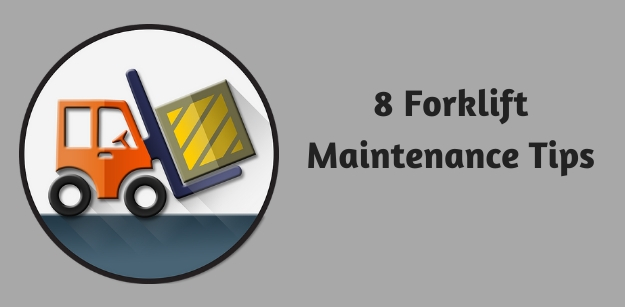Keeping a forklift in top shape requires maintenance similar to autos. They will have periodical scheduled maintenance to be done by either the business or an authorized mechanic.

Keeping the forks within specifications
As a forklift is used, the main part, the forks are worn down due to regular use. This is normal, but it also brings around the time for inspection. Basically, the forks should be checked for cracks and other anomalies. If some non-destructive crack detection can be employed, this would be great. While inspecting cracks on the fork, it is also time to check the welds of the mounting blank. All other connecting parts should also be inspected at this time and replaced if they are out of tolerance.
Deformation is a common problem with forklift forks that may have been overloaded. Be sure to check for the correct, as in original, angle for the forks. Is the fork blade straight? If the blade has been bent and is now out of tolerance with factory specifications, this should be taken into consideration. Maintaining strong forks for your machine is one of the best maintenance tips out there.
Check the pressure of the tires regularly
Forklifts carry tons of weight every day that they are used. Day in and day out the tires are the ones that carry the huge loads around. It makes sense, therefore, to take a look at the wheels and tires on a regular schedule. The tires should be checked for the right air pressure and that they are within tread limits. The load-bearing tires and wheels should receive more attention, for obvious reasons. Check the wheels for cracks with a careful eye and replace them when you see them.
Listen to the engine with the hood open
Although the engine needs to be maintained by a mechanic, there is still a need to be careful with it, even if it is fairly new. If the engine makes clicking noises that are not familiar, there may be a problem. Diesel engines are going to make more clatter, while propane forklift engines will make less noise. Taking a close note of how the engine sounds on a newer similar forklift can be advantageous for this type of preventative maintenance.
Check for overheating of parts
After a hard day of work, a forklift may have overheated. Checking for this in the summer months is obvious. Again, lifting the hood and examining that things like tubes and plastic parts are not deformed is a smart way to maintain a forklift. When mechanical things overheat, they also put out a smell that is not pleasant. Take a whiff under the hood of gas or diesel-powered forklifts after lifting an abundance of heavy things. It may not smell like roses, but it should not smell like burnt oil either. If the hydraulic oil for lifting runs through this area, make sure it has not overheated.
Checking for operational integrity
Take the forklift for a ride. The brakes should be the first thing to check. Do they feel like they could stop safely? Check the motor while it is under stress. It should perform smoothly without balking. The emergency brake should hold, especially on an incline. The chains that lift loads should operate freely and without obstruction. The gear shift is to be checked for normal operation, along with the clutch pedal. Lights should work, including warning lights on the dash. If the owner’s manual is not available for the forklift these maintenance procedures should still be followed regularly.
Checking hydraulic oil for the correct level
The hydraulic pump that creates the pressure to lift with a forklift is an integral part of a forklift. It should be checked, along with the level of oil in the reservoir. Before checking the level, make sure that the forklift is not parked on an incline. Check to see if there is a sight gauge for the oil. If not, the owner’s manual will tell if the oil should be filled up to the top of the reservoir or not. Make sure to use the right type of hydraulic oil in the system.
Checking for foreign objects
A forklift that travels long distances may pick up unwanted cargo. Underneath is the place to check for unwanted sticks, trash or any other debris that may have been picked up during the course of a workday. Forklifts that travel on unpaved sections should be checked regularly for other objects that have decided to get stuck under the carriage of the lift.
The horn and seatbelts are not to be missed
Although some do not think about it, the horn of the forklift is an important part of the machine. The horn should sound and the button should not be hard to press or be intermittent. The horn is the life-saving feature of the forklift, even if it is seldom used. A horn check should be done for every shift.
The seatbelts are another life-saver that some do not think much about. The truth is, if the forklift should tip over, the seatbelt may be the only thing that keeps the driver from being crushed. Check them on every shift, and make sure they are serviceable for a happier and safer workday.
For more information, visit us at: https://northcoastforktruck.com.au
